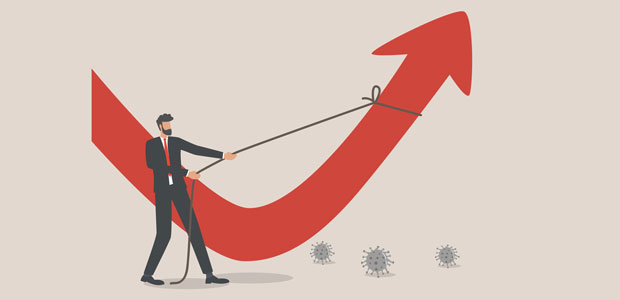
What We Can Learn From Businesses Who Flourished During COVID?
When the knock-on effects of the coronavirus pandemic and subsequent UK lockdowns are discussed, much of the focus is on the negative impact on the economy, our physical health, and our mental health. But, while the damaging effects are unlike anything we’ve ever witnessed, it’s not all doom and gloom.
While many businesses have suffered as a result of the pandemic, others have flourished. Exercise equipment, homeware, DIY, and gardening retailers, amongst others, were some of the businesses that flourished during the first national lockdown. When it comes to business-to-business, technology providers, ecommerce sites, video conferencing software solutions, and healthcare providers led the way. So did the companies who tapped into their services.
While many of the B2C successes were driven by changing consumer habits as a result of COVID-19 restrictions, there’s a common theme amongst the majority of organisations that succeeded: the successful adoption of technology.
The pandemic accelerates technology adoption
When the Prime Minister issued the work from home directive in March 2020, many businesses were unprepared for this huge shift. Issues including a lack of cloud software or portable work devices meant many organisations couldn’t adapt swiftly. Businesses that had already prioritised this digitalisation, however, were ahead of the game and were able to shift to home working with little to no disruption.
As a result of this situation, businesses implemented digital solutions to keep an element of normality through remote working and collaboration. It also meant many businesses accelerated their digitisation.
A global McKinsey survey of business executives in July 2020 backs this up, finding that businesses fast-tracked their long-term digitisation plans and accelerated the process by three or four years. Further, businesses sped up the digitisation of their products and services by seven years. This is a result of the increased funding for digital initiatives, which was the leading business area that received internal investment during this time.
While 'nearly all' of the survey respondents said they’d implemented temporary measures and solutions to allow their businesses to adopt this new way of working, the majority expect their investments to be long-term. Importantly, senior executives are recognising technology as an essential element of their business instead of solely a cost-cutting tool.
The businesses reaping the rewards of digital investment
While businesses that had already invested in digitisation got a head-start in the pandemic and the subsequent shift to home working, that’s not to say businesses who adopted digital in the past 12 months weren’t also winners. The McKinsey survey shows 92% of business leaders knew prior to the pandemic that their business model needed to be digital-first to keep up with the competition, and that the pandemic 'just put that whole scenario on steroids'.
Michael Kors
High-end retailers have experienced difficulties as a result of COVID-19. We witnessed the sad loss of Debenhams’ flagship stores, while Burberry’s retail sales fell 48.4% in the first three months of the pandemic.
As a luxury fashion brand, Michael Kors relied on in-person shopping because its in-store experience was as important as the quality and style of its products. When the COVID-19 pandemic hit and its physical stores closed, the brand had to adapt quickly. Pivoting to digital, the company launched a brand-new service online which allowed consumers to create their own customised bags or receive tailored product recommendations.
The MK My Way service was offered on Tmall, an e-commerce site from Alibaba, and began with a personality quiz which would then make a personalised recommendation to the user, with the option of having a customised, hand-painted bag created. On the first day of the digital pop-up event exclusive to China, MK My Way’s Tmall store received 1.3 million visitors and generated £1.41m. Thanks to this success, the company has since rolled out the service globally.
BJS Haulage
The haulage and logistics sector is one that has experienced an increased demand from businesses and consumers alike thanks to the acceleration of online shopping. While this is largely positive, it left businesses in the sector which hadn’t digitised struggling to keep up with demand.
This certainly wasn’t the case for home delivery specialist BJS Haulage, which experienced growth and adopted digital to ensure it could manage its growth effectively and adapt to increasing demands. The business had expanded its fleet of articulated lorries and updated its back-office systems to support diversification into the general haulage market.
The company implemented a transport management system, a sector-specific digital solution that gives hauliers real time visibility of their operations and in-progress deliveries and supports processes from order to invoicing. The ability to manage load planning and offer customers visibility of their deliveries has dramatically reduced the volume of calls the business received from clients requesting updates. The business also eliminated manual paperwork and duplicated data entry thanks to switching to a transport management and app-based proof of delivery process.
Spotify
The most successful music streaming service was seemingly well-placed when the pandemic hit. Not only is it a fully digital business, but many people found themselves with more time to engage in music and audio media. But there was one problem: its customer base was primarily non-paying users who, in return for free streaming, would be served audio adverts. Meanwhile, competitors with strong USPs, including Apple Music and Tidal, did not offer a free service. Many of Spotify’s advertisers also reduced their budgets in the face of the pandemic.
Spotify took a page from Netflix’s book and turned to the production of original content. The platform focused on offering exclusive podcasts to subscribers, seeing over 150,000 podcasts uploaded by artists and users in April 2020 alone. The brand, therefore, began to position itself as a broad audio platform instead of only music streaming. Spotify also poached The Joe Rogan Experience, one of the most popular online podcasts, from competitors Apple.
This pivot paid off, with the business increasing its paid subscribers by 34 million between March and December 2020 to 155 million. The business has also won plaudits for arguing against raising its subscription prices, currently £9.99 a month, because its services could become 'unaffordable for consumers'.
What can we learn from these businesses?
In these difficult times, it’s natural for businesses to look at cost-cutting measures to keep their heads above water. These businesses, however, prove that strategic investments in digital are the key to success in difficult times. But there’s also no one right way to do it - your digital initiatives must match your business’ goals, specific challenges, and market. Michael Kors, which offers a luxury in-store experience and therefore relies on physical footfall, had to adapt to an entirely new way of selling its products. Exploring a digitised version of in-store selling, as well as broadening its product offering, allowed the business to mitigate the impact of store closures.
BJS Haulage, meanwhile, proved that digital doesn’t have to be flashy. Implementing a tailored back-office solution might not seem like the most exciting use of digital. However, it’s the best way to implement digitally transformative solutions because it meets a critical business need. Digital business Spotify, meanwhile, highlights the importance of not standing still. The company was in a strong position when the pandemic hit, but expanding its service offering gave it an extra edge in an increasingly competitive market.
If there’s one thing we’ve learnt from the COVID-19 pandemic and its impact on businesses, it’s that digital is now essential to survival. Much of the media attention has focused on the negative impact of the pandemic, with many businesses unable to operate and some unfortunately not surviving. But there are also a lot of positive stories amongst the negatives, and your business can learn from their successes.


